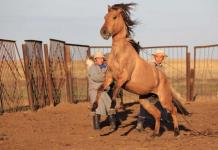The Sumatran barb, which belongs to aquarium fish, lives on the islands of Sumatra, as well as in the reservoirs of Kalimantan Island. This fish belongs to the ray-finned species and belongs to the carp family. In Russia, the barb appeared in 1947.
Sumatran barbs have a "dense body", slightly compressed from the sides, color - olive brown. But there are also silver, yellowish-golden, or pink fish. The body of the barbus is painted with 4 black stripes, one of which is located on the eye. An interesting feature is the less bright body of the female, but it looks larger, and the belly is rounded. The color of the anal and dorsal fins in females is transparent in the edging. Males are distinguished by bright red edging of fins. The body length is about seven centimeters. This kind aquarium fish unpretentious in the content, therefore, in pet stores, consultants recommend barbs to lovers of aquarium fish who do not yet have experience. The fish are quite frisky and active, they have a cheerful, slightly aggressive disposition. Barbs live for about four years.
Barbus sumatran content
As mentioned above, it is quite easy to keep this fish, but because the fish is frisky enough, then you need to find a more spacious dwelling for it. Typically, a 50-liter, soft-lit, rectangular or square-shaped aquarium is sufficient. The most suitable water temperature is between 21 and 25 degrees. It is believed that the water must be settled for two to three days, and then poured into the aquarium. The hardness of the water does not really matter in the content of these fish. If you want your barbs to acquire a brighter color, place a dark soil on the bottom.
There should be a lot of aquarium plants, with small leaves, including those that have the ability to stay in the water column without falling to the bottom. It is best to put Javanese moss on the bottom of the aquarium, and in the corners, place the branches of lush plants. Barbs also like the interior of the aquarium, where there are small caves, depressions, secret places between plants. Put a small decorative snag on the bottom: this will remind the fish at a genetic level of life in an open environment.
It is necessary to enrich the water in the aquarium with oxygen, but so as not to create currents. Filtering is also required. Usually, in order for the water to be clean and well enriched with oxygen, it is enough to turn on the compressor twice a day for twenty minutes.
Sumatran barbs are unpretentious in feeding. You can feed both dry special food and live. Supplements should be present in the diet of fish. vegetable origin, preventing the fish from gaining excess weight, as well as helping to increase immunity to various diseases. In addition, if the barbus menu does not have enough plant food, it will begin to gnaw at the aquarium plants, which is very bad. This quality of fish is explained by their gluttony: no matter how much food you give the barbs, everything will be eaten without a trace. Therefore, food, which also contains protein (for example, bloodworms), should be given in small portions and no more than twice a day. The food from the Tetra company has become very popular among aquarists. You just have to choose a jar designed for barbs. This company has also developed food that enhances the color of the fish, as well as fortified with vitamins.
Barbus sumatran breeding
Barbs acquire the ability to reproduce at the age of one year. But often, having reached nine months, the fish begin to show interest in the opposite sex. If the food that you give to your pets is varied enough, then by six months your fish will already be ready to “conceive”.
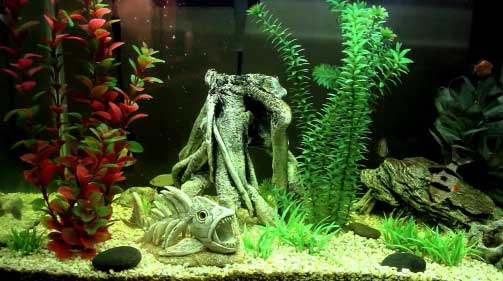
If you have never been engaged in breeding aquarium fish, then barbs are more suitable for this purpose than other species. Although it is not necessary for barbs to place "boys" and "girls" in different aquariums, they still need to be settled. Without the "harassment" of the male, the female can easily gain eggs. As a rule, it lays about five hundred eggs, which are about one millimeter in size and are closer to light yellow in color. Unfertilized eggs (they have White color) are removed from the aquarium.
For caviar to develop better, it is necessary to include proteins in the feed, as well as fats and carbohydrates. In addition to the bloodworms mentioned by us, you can enrich the feed with a coreter and a tubule. The water temperature in the aquarium should be maintained at 25 - 26 degrees, then spawning will be more intense.
Prepare a special aquarium for spawning, with a volume of about ten liters. It is advisable to lay out the bottom with a separator mesh that can protect the eggs from death: parents sometimes eat their future children. The snails must be removed. In addition to the javanese moss mentioned above, you can also lay the bottom with synthetic canvas. The filter cannot be turned on.
Breeders of your choice should be placed in the spawning tank in the evening. And in the morning, as a rule, spawning occurs. Sunrise is a kind of signal for fish to spawn. The whole process takes two to three hours.
After the female spawns (the females are removed from the aquarium after spawning), the water in the aquarium must be partially replaced. To avoid the appearance of fungus, add methylene blue to the water (until it turns blue). The best option to increase the stimulation of spawning, there will be a darkening of the spawning grounds, or, in extreme cases, it is necessary to exclude direct sunlight from entering it.
After a day, or a little more, fry begin to hatch from the eggs. In the first days of life, they trite hang on aquarium plants, and after five days they already acquire the ability to swim, keeping as close to the ground as possible. And at this time, the fry already reach five or more millimeters in length. Daphnia and cyclops are food for fry at this age.
Sumatran barbus compatibility with other fish
It is best to keep barbs separate from other fish: for example, those that have veil-tailed fins and tails. Barbs gnaw and flap the "pride" of such fish. Snails in a barbus aquarium will also have a hard time, as the fish constantly try to attack them. If you decide to keep the fish in pairs, they will annoy your neighbors. There are often cases when barbs killed other fish to death: bitten tails and fins are just flowers. Therefore, it is enough to launch a flock of five or six individuals into the aquarium, and they will begin to pay attention exclusively to each other, building a hierarchical ladder. 
Fish such as telescopes, gurus, sklyars will also be attacked by barbs. These fish zealously defend their territory: an alien fish that accidentally swam there is immediately expelled by barbs. And you will be able to observe how the "owners" will gracefully and proudly swim in their protected area of the aquarium, and the rest of the inhabitants, with despondency and regret, only look in their direction, looking out of hiding.
But it is possible to reconcile barbs with other types of aquarium fish, if they are placed in the aquarium later than others. In other words, if the house is already occupied by tenants, then the barbs will show courtesy and at least some respect. You can also add barbs to the fish, which will be able to "put the insolent people in their place."
Do not release fry of other fish into the aquarium where barbs live. Despite the fact that barbs are not predatory fish, they will pursue fry and swallow them greedily. And this will continue until there are no fry left in the aquarium.
Among other things, other species of fish that are in the aquarium with barbs, from constantly flickering in front of your eyes and scurrying back and forth, can get shock and stress from such behavior of their new neighbors.
But it will not be fair to talk about the aggressiveness of the fish we are considering: after all, by and large, all the cases we have listed occur quite rarely. All the aggression of barbs can only consist in the fact that other fish will be pursued by them until they leave the protected area.
Sumatran barbus (lat. ), is a representative of the carp family. This species is one of the most popular and widespread barbs. Very popular with indoor aquarium lovers.
Natural habitat.
Natural habitat barbus sumatran are the water bodies of Southeast Asia and Indonesia. Artificially transported to European countries in mid-1935. In Russia he ended up in the region of 1946. The habitat is distributed within Kalimantan, Thailand, Indonesia, Malaysia and Sumatra.
The size and shape of the body of the fish.
This is the largest member of the genus. According to confirmed data, the longest individual reached seven centimeters. There is information that there were larger specimens. Behind the glass of the aquarium, these barbs are rarely more than 4-5 centimeters. It should be noted that females are always larger than males, this is one of the distinctive features sexual dimorphism, which is relatively weak in this species.
The fish have a flattened body shape that looks like a horizontally elongated rhombus. No mustache.
Coloring.
The color of fish is represented by darker colors on the back, gradually lightening towards the abdomen and has a palette from golden to pink shades. One of the main differences between these barbs is the presence of four stripes located on the sides and going vertically from top to bottom. The first line crosses the eye; the second is next to the pectoral fins; the third is immediately behind the dorsal fin, and the fourth is in front of the caudal. All paired
Flock idyllthe fins of this species have a red or dark pink color palette, the dorsal fin is always black with red edging. More saturated colors were noted in the male representatives of the species. Aquarium fish, thanks to selection work, have a richer range of colors, in contrast to fish grown in the wild.
Aquarium keeping of barbs.
Sumatran barbs lead a gregarious lifestyle, always peaceful and very mobile. It was their constant activity that greatly popularized the species among aquarists. Typically, the life expectancy of fish in an aquarium, with proper care, is three to four years.
The fish huddle in small schools and, as a rule, spend the greatest amount of time in the middle layers of the water or closer to the bottom. They prefer an aquarium that is densely planted with plants, but has openings for open, free swimming.
The aquarium can be used not very large. Tanks with a capacity of more than 60 liters are best suited. To preserve the brightness of the color of the fish, it is better to use the soil of dark tones, since in the light versions they turn pale, trying to merge with the surrounding conditions.
For a peaceful relationship of barbs with neighbors of other species, it is desirable to fulfill a number of conditions: the aquarium should contain from 6 to 12 representatives of the species, the rest of the fish should be peaceful, but individuals capable of protecting themselves. It is important to know that if the number of barbs of the same species in a flock is less than 4-5 individuals, they will be extremely aggressive towards each other.
It may happen that one of the fish will fight off the flock and will be alone for a long time, not showing activity. In this case, do not worry, this is a common behavioral reaction in barbs.
 Another pretty flock
Another pretty flock Sumatran barbs are not predators. However, if the opportunity arises, they will immediately eat the newly appeared fry of any fish. A flock of barbs will hunt young animals until they overfill everyone. You can not settle with them in the same aquarium slow fish and individuals with long veil tails and fins or long whiskers. Barbs will constantly bite them by the ends of the veil, bringing constant discomfort and stress. This is especially true for all varieties. They are generally peaceful, slow-moving and often have luxurious veil fins. Also, the heroes of our story love to pull the mustache of all kinds.
It should be noted that even if all the conditions are met, males love to measure their strength with each other. Fortunately, these skirmishes end quickly enough and do not cause any damage or injury to the fish.
The fish do not need any exotic conditions suitable only for them, and they feel great in the classic environment, suitable for most warm-water species. You should just not forget about constant filtration, oxygen supply and changing part of the water in the aquarium. The best water temperature is 21-23 degrees Celsius. The acidity should be between 6.5 and 7.5.
In nutrition, Sumatran barbs are absolutely not picky and will eat both animal and vegetable types of food with the same appetite. But, you need to know that these fish can eat in excess quantities, which often leads to their death.
Breeding of Sumatran barbs.
These fish become capable of reproduction when they reach six months of age. Spawning can occur at any time period. Before the breeding period, it is necessary to keep female and male individuals separately from each other for 20-30 days, at a temperature of 22-24 degrees.
Fish spawn both in pairs and in schools, in a separate aquarium, more than 10 liters in size. It is not necessary to place the soil on the bottom; instead, it is necessary to lay a net with a small mesh, so that mature individuals do not have access to caviar, since they will eat it with appetite. Snails in such an aquarium should be absent for the same reason. water should be about 26-28 degrees, it is in these conditions that spawning of barbs is more active.
In the process of postponing the game, you should not feed the fish.
After transferring adults back to the general aquarium, a little methylene blue must be added to the water with caviar to destroy possible fungus on the surface of its shell.
After 3-4 days, cubs appear, which immediately begin to actively swim and search for food. It is necessary to feed them with any of the smallest available food. After a month, the fry will begin to acquire a beautiful color of adults and, after its full formation, the fry of the Sumatran barbus can be planted in a common aquarium.
photo can be enlarged
The Sumatran barbus has long been one of the most common aquarium fish. Today there is a wide variety of different species of this popular aquarium fish: albino forms, green barbs, golden sumatran barbs, scarlet, mossy, and so on. They all differ in color, but the behavior and general provisions of their content are quite the same. Well, maybe with the exception of especially rare or endemic species.
This nimble fish got its name due to the fact that it owes its origin to the island of Sumatra. This, along with and, is well suited for novice aquarists. The Sumatran barb is not picky about its content, it adapts well to different water hardness and acidity. Characteristic feature its appearance is four vertical black stripes, which are located against the yellowish or silvery background of these fish. The size of the Sumatran barbus when kept in an aquarium reaches 6-7 centimeters, and the life expectancy is 4 years. How long the Sumatran barb lives is mainly determined by the conditions of detention and the variety of its diet.

photo can be enlarged
Sumatran barbs are very mobile, peaceful schooling fish. High mobility and beautiful color make them one of the most interesting inhabitants. In the aquarium, these fish are kept in schools in the middle and lower layers of the water. For their maintenance, it is advisable to have an aquarium of 50 liters or more, densely planted, but having open areas for swimming. It should be noted that when kept in a light aquarium, the color of Sumatran barbs turns pale, therefore, to preserve their beauty, it is worth using a dark soil.
V common aquarium a flock of 5-10 Sumatran barbs can be kept with other peaceful, but able to fend for themselves fish. With fewer barbs in the aquarium, they become very aggressive both towards each other and towards other inhabitants of the home reservoir. The Sumatran barbs look especially beautiful with other fish from the same natural range, which have a similar color - for example, with clown battles.
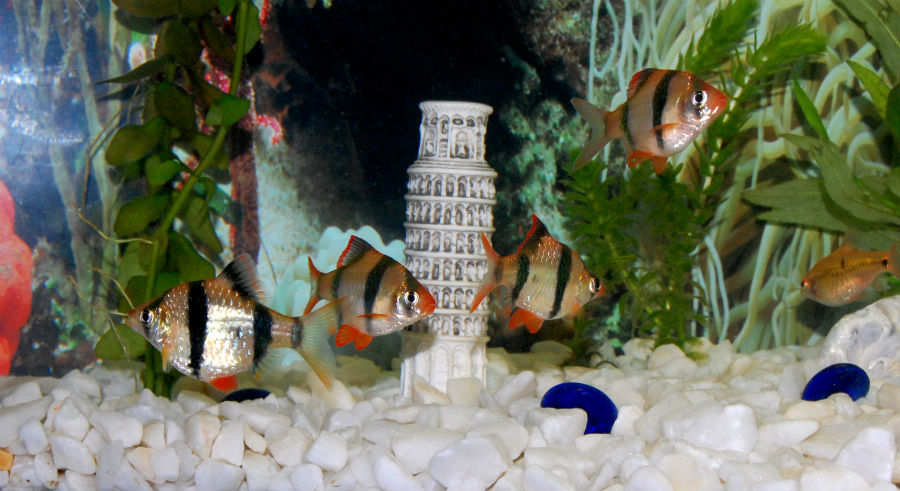
photo can be enlarged
Sumatran barbs cannot be called predators, but, nevertheless, they instantly eat the fry of other fish that have just appeared. At the same time, the whole flock will not calm down until they have caught all the fry in the aquarium. These aquarium pets are poorly compatible with sedentary veil-shaped fish, because barbs can nibble the edges of their fins, spoiling appearance their neighbors. In addition, other inhabitants of the aquarium can experience a lot of stress from the fast moving flock of barbs.
Keeping Sumatran barbs is not difficult. The optimum temperature for aquarium water is 21-25 degrees Celsius. The good news is that the composition of the water does not play a special role. As usual: change the water once a week for a fresh 1/5 of the volume. In order for the barbs to stand out better in your aquarium, it is preferable to take dark soil. It is good if you have a lot of aquatic plants rooted in the ground in your aquarium. And it is also desirable that there are also floating plants. Like most aquarium fish, the Sumatran barb loves water with low currents.
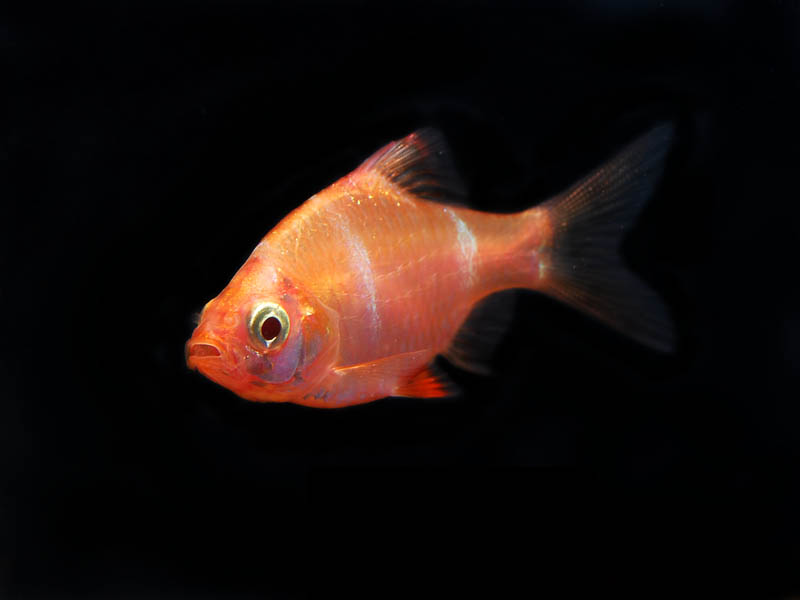
Albino barbus
photo can be enlarged
The Sumatran barb is unpretentious in feeding, as it perfectly eats dry, frozen, industrial and live feed. Adults Sumatrans also need additional plant nutrition. They will happily eat some plants or glass. This type of barbs prefers to feed mainly in the water column, but if necessary, it can take food both from the bottom and from the surface. In no case should you overfeed Sumatrans, as they are highly prone to obesity. To prevent this from happening, feed them once a day and in small portions. Try to do a fasting day for Sumatran barbs once a week - let the day go hungry.
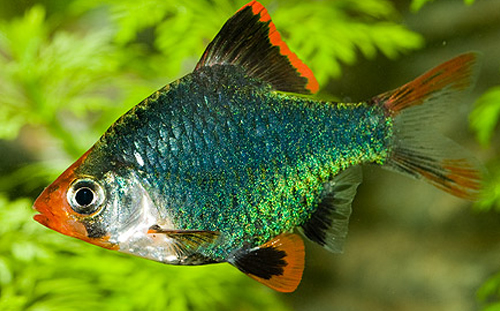
Mossy barb
photo can be enlarged
Under normal conditions, especially after replacing part of the water, the fish, having gathered in a flock, swim briskly in the aquarium. Sometimes, huddled in a shaded corner of the aquarium, the barb can stay in one position for hours with almost no movement. In this case, the fish is kept in an inclined position, with its head down. This condition is normal for the fish and should not bother. Males have a warlike character and at times in the presence of females, having fluffed up their fins, enter into a fight with each other: they seek to grab each other by the jaws, push with the side surface of the body or pinch with their mouths. Usually, these fights do not lead to noticeable damage and end with the fish disperse and again swim peacefully in the school.
In the "old", long-lasting water, which has accumulated a large number of waste products of the Sumatran barb are often sick. He is also prone to overeating and obesity.
Breeding and reproduction
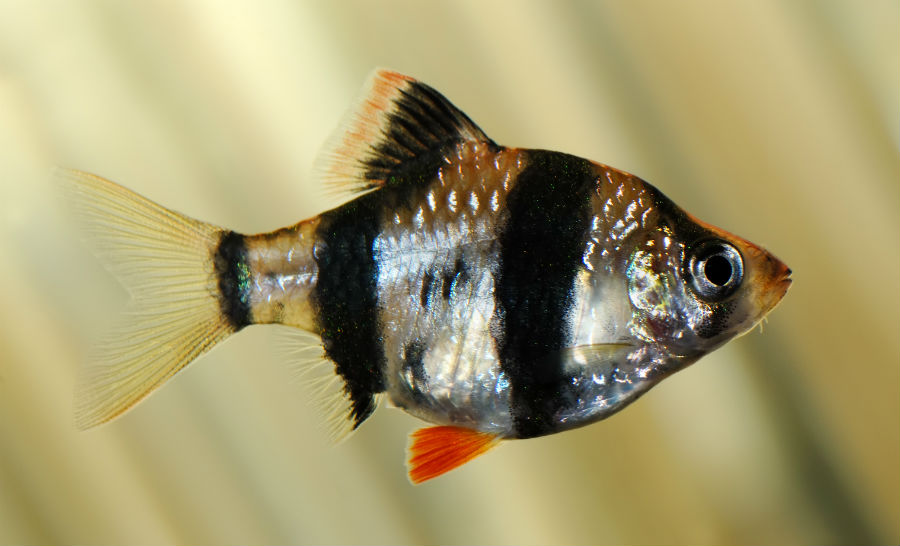
photo can be enlarged
If you decide to breed this beautiful and unpretentious fish, this is not difficult to do. Sometimes amateurs even allow spawning in a common aquarium - at the same time, excess eggs are removed from the females. If the female has not spawned for a long time, she becomes ill and may die. True, the barbs immediately eat up the offspring, so it is better to provide them with a separate spawning ground. A vessel with a volume of 10 liters or more is suitable for this. Maintain the water temperature at 25-26 degrees, gH up to 8.0 °, pH - 6.5 °. Choose young individuals, with males older than females. Spawning can be paired or group spawning. The female can be distinguished by her larger body size and thick abdomen, while the males are brighter and more intense in color.
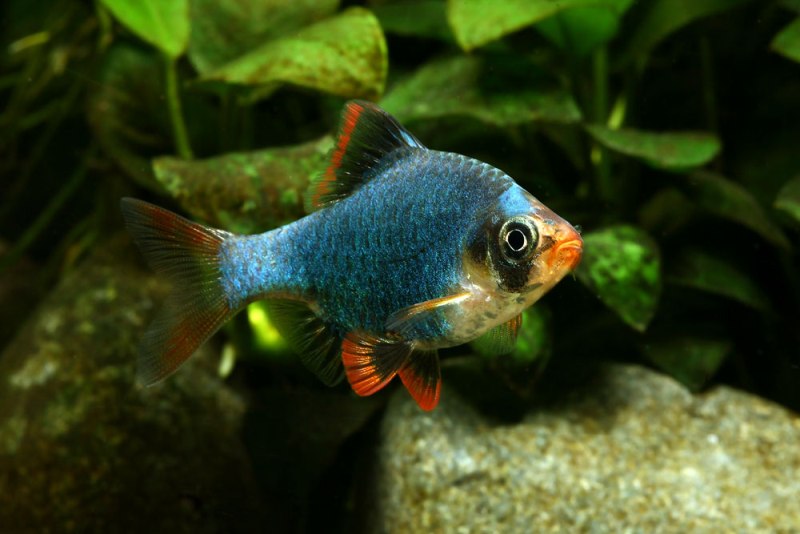
Barbus mutant
photo can be enlarged
Before spawning, the selected fish-producers are seated in separate containers and fed with low-fat and plant foods. During this period, males are quite aggressive, so it is undesirable to place them together. Small-leaved plants are planted in the spawning aquarium, on which the females will lay eggs. Professional aquarists use special lattices or thin nylon line woven into a ball. Aeration should be weak, it is better to turn off for a while, producers are not fed in the spawning grounds.
Barbs are placed in the spawning grounds in the evening, since the process begins after 12 hours. The female spawns 400-600 eggs, which the male fertilizes. After that, the fish are removed so that they do not eat the offspring, the aquarium must be placed away from the window so that direct sunlight does not fall on it. It is advisable to add an antifungal agent to the water. The larvae hatch within a day, and after 3-4 days they turn into fry and begin to feed on their own. Food for babies is live dust, ciliates, and then other food. You can also use industrial feed, the bottom must be periodically cleaned of food debris, and the water must be changed regularly. Barbs grow unevenly, so you will have to sort the fry according to their growth and transfer them to other containers. Gradually, the temperature in the aquarium can be reduced to 24 degrees.
Mutant barb, mossy barb, green sumatran barb
The mutant barb or the mossy barb or the green Sumatran barb is one of the most unusual forms of the Sumatran barbus. The combination of dark blue or dark green with black and orange fins is truly amazing. This variety of barbs requires the same conditions of detention as for their progenitors, the Sumatran barbs. Like all barbs, they are best kept in a group of 6 or more individuals. It should also be borne in mind that these are very lively and mobile fish, so they need enough free space for swimming.
To create an interesting design in your aquarium, you can plant several common Sumatran barbs, as well as albino forms of Sumatran barbs, along with mutant barbs. The combination of several shapes creates a truly breathtaking picture. Despite the fact that with age, the bright color fades a little, these mobile fish still create an amazing sight in the aquarium.
These active and fast swimming fish need a flock. It is very curious to watch them when in a flock of about 6 individuals they create their own hierarchy. Barbs are known to have a habit of ripping off the fins of other neighboring fish species. It is worth noting that this happens when they are not contained in a flock. This is probably because, swimming in a flock, they are busy chasing each other.
The body color of the mutant barbus is deep dark green or blue with a metallic sheen. The four black transverse stripes typical of the Sumatran barbus are absent. The dorsal, pelvic and caudal fins are red. The anal fin is transparent. During the spawning period, the head also turns red.
The mutant barbus can be fed with live food (, koretra,), vegetable, dry. This fish will eat as much as you feed them, so the aquarist should dose the feeding consciously.
The mutant barbus swims in all layers of water, but prefers the middle one. This is an active fish that needs a lot of free space. For sexually mature fish that live in a flock of 7 individuals, an aquarium of 70 liters or more is needed. It is important that it be long enough, with space, but at the same time planted with plants. Remember that barbs are great jumpers and can jump out of the water.
They adapt well to different water conditions, but do best at pH 6.0-8.0 and dH 5-10. They naturally live in soft and acidic water, so lower numbers are preferred. That is pH 6.0-6.5, dH about 4. Water temperature - 23-26C.
Albino barbus

photo can be enlarged
This subspecies is the result of the selection of the Sumatran barbus, which received a new body color, it can vary from yellow to creamy with colorless stripes. The biggest difference with its predecessor, apart from color, is that albino does not always have gill covers. Other common names are Golden Tiger Barbs, Platinum Barbs.
In most cases, in the process of selection, fish become demanding on the conditions of detention, as happens with any artificially bred animals. In the case of albino barbs, it was possible to avoid a similar situation, it is no less hardy than the Sumatran barbus and can be recommended, including for novice aquarists.
The fish is not demanding on the conditions of detention, the only important requirement is pure water, for this it is necessary to install a high-performance filter and replace 20–25% of water with fresh water every two weeks. The filter solves two tasks at once: it cleans from suspended matter and harmful chemicals and creates the movement of water, this allows the fish to be in good shape and show their color brighter.
The barbus prefers to swim in open areas, so free space should be left in the middle of the aquarium, and plants should be densely planted in a sandy substrate at the edges, where you can hide. Pieces of driftwood or roots will be a great addition to the decoration, and will also serve as a basis for the growth of algae.
It is advisable that the length of the tank exceeds 30 cm, otherwise for such an active fish, a small enclosed space will cause discomfort. Having a lid on the aquarium will prevent accidental jumping out.
In favorable conditions, health problems do not arise if the water quality is not satisfactory, the barb becomes vulnerable to external infections, primarily ichthyophthyriosis.
All aquarium breeders certainly know the Sumatran barbus. This funny fish got its name due to the fact that it owes its origin to the island of Sumatra. This pet is great for novice aquarists. The Sumatran barb is not picky about its content, it adapts well to different water hardness and acidity. A characteristic feature of its appearance are four vertical black stripes, which are located against the background of the yellowish or silver color of these fish. The size of the Sumatran barbus when kept in an aquarium reaches 6-7 centimeters, and the life expectancy is 4 years. How long the Sumatran barb lives is often determined by the characteristics and variety of its diet.
How to feed Sumatran barbs?
Sumatran barbs will not give you much of a hassle and will happily consume the food offered. Whether dry or live. But if you want to raise highly active and reproductive individuals, it is still better to focus on live food. Also, vegetation must be present in the diet of adult Sumatran barbs. If you start to neglect this recommendation, then you run the risk of being eaten. Thus, the fish compensate for the lack of this species. nutrients... In addition, without herbal supplements, Sumatran barbs can develop obesity and other illnesses. These pets are, in principle, prone to recruitment excess weight, so you need to feed them carefully, without overfeeding, once a day. And sometimes it is useful to arrange a fasting day for them, depriving them of feed altogether. But such drastic measures are best carried out no more than once every 10 days.
The Sumatran barb is a schooling fish. Given this feature, it is advisable for breeders not to limit themselves to one, but to start 6-8 pieces. Otherwise, a lonely Sumatran barb will be excessively active in the aquarium and annoy the obsession of its other inhabitants.
If we talk about the compatibility of the Sumatran barbus with other fish, then it is quite good. The only exceptions are especially those whose size significantly exceeds its parameters. Otherwise, your pet may simply be eaten. And the Sumatran barb itself is not averse to pinching the long tails and fins of the fish that have them, to show aggression towards them. Based on this, it is not recommended to keep long-tailed fish in the same aquarium with them.
How to determine the gender of Sumatran barbs?
Females of Sumatran barbs have external differences that allow them not to be confused with males. Females have a less bright color, as well as a fuller abdomen than males. In addition, females are noticeably larger, this is clearly visible with the naked eye.
Usually, Sumatran barbs reach maturity when they reach 1 year of age.  Starting from this age, if the content was correct and the food was of high quality, the breeder needs to prepare for the breeding of his beloved pets.
Starting from this age, if the content was correct and the food was of high quality, the breeder needs to prepare for the breeding of his beloved pets.
The fertility of a female Sumatran barbus reaches 500 eggs at a time. But do not be alarmed at once - not all of them will be fertilized and become full-fledged fish. If the female has not spawned for a long time, she can simply get sick and die. Therefore, you need to approach the reproduction process as a natural necessity.
The fry and caviar of Sumatran barbs, when breeding them in common aquariums, are often eaten both by themselves and by various neighbors. Therefore, for the safety of the offspring, we advise you to take care of individual vessels in advance and grow fry in them.
Barbus tetrazona
Description of the Sumatran barbus: Inhabits water bodies of Indonesia and Southeast Asia. (a native of the island of Sumatra) The Sumatran barbus was first introduced to Europe in 1935, and to Russia in 1946.
Sumatran barbs are gregarious, very mobile fish. The body of these barbs is high, strongly compressed from the sides. . No mustache. The general color is golden-pink, the back is darker with a red tint, the abdomen is yellowish-white. There are four vertical black stripes on the sides. The first passes through the eye, the second behind the pectoral fin, the third behind the dorsal fin, and the last at the beginning of the caudal fin. The dorsal fin is black with a bright red border; other fins are pink or red. Females are larger than males with a fuller abdomen. . The color of the males is brighter, the red color of the fins is more saturated. It should be noted that in nature the Sumatran barb has a faded color than its aquarium relative. In the aquarium, Sumatran barbs prefer to keep in flocks. . They are mainly kept in the middle and lower layers of water... To keep these fish, it is advisable to have a densely planted aquarium (from 50 l) with open areas for swimming. The soil is better dark, otherwise the fish acquire a paler color. A flock of 5-10 or more Sumatran barbs can be kept with other peaceful, but fend for themselves fish. It is important to note that with a small number of 2 - 3 fish, these barbs can show strong aggression both towards each other and towards other inhabitants of the aquarium. Sumatran barbs do not belong to predators, but if fry of any fish appear in the aquarium where they are located, they instantly grab the fry with a throw and swallow it. In this case, the barbs will not calm down until they have overfished all the fry. The exception is sedentary and veil forms of fish, in which barbs can bite off the ends of their fins. In addition, a swarm of Sumatrans moving quickly around the aquarium can cause constant stress and discomfort for other less active inhabitants.
Sumatran barbs are unpretentious, a favorable temperature is 21-25 ° C, good filtration is necessary in the aquarium, regular water changes (1/4 volume once a week) and can be planted with any plants, but it is better to give preference to small-leaved plants (kabomba, myriophyllum). If the aquarium does not have air purging, it is advisable from time to time to replace some of the water with fresh water of the same temperature. This water change is very beneficial for the fish. Compared to others, the fish is less sensitive to the lack of oxygen in the water. If the fish still swims near the surface with its head up, the water must be changed immediately.
Sumatran barbs are omnivorous and eagerly eat any live and artificial food. A feature of this species is the tendency to overeat (the cause of obesity and death of fish). To avoid this, you need to carefully monitor the amount of feed and use the rule - it is better to underfeed the fish. In addition, it is advisable to include plant foods in their diet, for example, lettuce leaves, nettles, dried seaweed, etc.
Feeding any aquarium fish should be correct: balanced, varied. This fundamental rule is the key to the successful keeping of any fish, be it guppies or astronotuses. The article talks about this in detail, it outlines the basic principles of the diet and feeding regime of fish.
In this article, we will note the most important thing - feeding the fish should not be monotonous, the diet should include both dry food and live food. In addition, you need to take into account the gastronomic preferences of a particular fish and, depending on this, include in its diet food either with the highest protein content or vice versa with plant ingredients.
Dry food is, of course, popular and popular food for fish. For example, every hour and everywhere you can find food of the company "Tetra" - the leader of the Russian market on aquarium counters, in fact, the range of food of this company is amazing. In the "gastronomic arsenal" Tetra includes as individual food for a certain type of fish: for goldfish, for cichlids, for loricaria, guppies, labyrinths, arowans, discus, etc. Also, the Tetra company has developed specialized feeds, for example, for enhancing the color, fortified or for feeding fry. Detailed information about all Tetra feeds, you can find on the official website of the company -

It should be noted that when buying any dry food, you should pay attention to the date of its manufacture and shelf life, try not to buy food by weight, and also keep the food closed - this will help to avoid the development of pathogenic flora in it.
In the photo, the female of the Sumtran barbus and the male
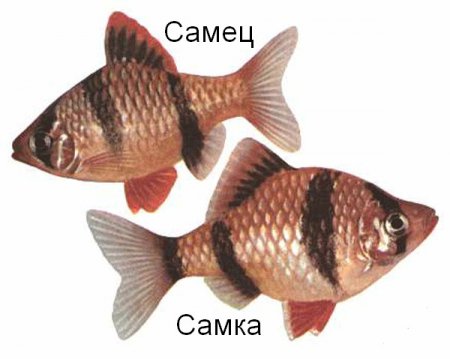
Under normal conditions, especially after replacing part of the water, Sumatran barbs, having gathered in a flock, swim briskly in the aquarium. Sometimes, huddled in a shaded corner of the aquarium, the barb can stay in one position for hours with almost no movement. In this case, the fish is kept in an inclined position, with its head down. This condition is normal for the fish and should not bother. Males have a warlike character and at times in the presence of females, having fluffed up their fins, enter into a fight with each other: they seek to grab each other by the jaws, push with the side surface of the body or pinch with their mouths. Usually, these fights do not lead to noticeable damage and end with the fish disperse and again swim peacefully in the school.
Life expectancy in an aquarium is 4 - 5 years. Reproduction becomes possible when the fish reaches the age of 5-9 months.
Additionally. For a long time, breeders have bred various variations of the Sumatran barbus, but the most popular are: the mossy barbus, the albino barbus and the black mutant barbus. It is interesting that only chance allowed us to admire the mossy barb, because earlier it was simply discarded in Asian fish farms, and then someone did not see it, and the fish got to Europe, where it immediately gained popularity among aquarists. From that moment on, the mossy barbus was bred on purpose. During its time in the aquarium industry, a fish with an unusual color received various names: mutant barbus, mossy barbus, Sumatran green barbus.
But it's true, the combination of dark blue or dark green colors with black on the body, and even orange fins looks mesmerizing.
A selection of videos about the Sumatran barbus
General information about barbs
Family Cyprinidae.
Barbs (genus Barbus) are spawning fish. There are several dozen varieties in nature. Distributed in Africa, South and Southeast Asia. Most of them are medium-sized schooling moving fish, the size of which is 4-6 cm. Small barbs are considered peaceful inhabitants of aquariums, but their aggressiveness is possible to the extent that they destroy other fish in the aquarium. In general, these are fast and nimble fish, which are in motion all the time, they are looking for something and catching up with each other. Suitable for aquarists who prefer active fish. Keeping them with sedentary neighbors is not worth it, because they will constantly bother, jerk, create a stressful situation. Large barbs can compete even with aggressive aquarium dwellers. Most of these species can be kept in aquariums from 50 liters. Barbus fish feel good at a fairly low temperature of 20-24C. The composition of the water does not play a significant role, these fish are used to living in running water. Therefore, it is advisable to create a flow in the aquarium by means of aeration. Small species contain a flock of 5-7 pieces. They usually have a life span of 3-4 years in an aquarium. Large fish, such as the shark barb, are often kept singly or in pairs, they live in captivity much longer. The color of the soil should be dark, in this case the fish look brighter. Planting plants for these restless fish should not be very dense, with space for swimming, because it is in open areas that the fish show their active character. The presence of floating plants is optimal for them. There should also be separate, densely overgrown places that serve as a shelter for them. As feed for most aquarium barbs almost any can be used: live - bloodworms, tubifex, daphnia, cyclops, frozen daphnia and bloodworms; various dry mixes based on dried daphnia; granulated industrial feed. For adult fish, the addition of plant components is desirable, otherwise, these inhabitants of aquariums can damage young shoots of plants.
Breeding most species of aquarium barb fish is not difficult. As a spawning ground, you can use a frame or all-glass aquarium from 10 liters. The water is old, with the addition of 30% fresh, settled. No primer required. The bottom should be covered with plants as a spawning substrate and to prevent broodstock from eating eggs. You can also use a net to separate the spawners from the bottom, in which case they cannot reach the eggs. Sometimes the producers have to be kept separately before spawning, sometimes the fish spawn like that, even in a common aquarium. Usually, if females have a clearly visible full abdomen, they are ready to spawn. A couple or a group of producers are planted for spawning in the evening. Spawning usually begins the next morning, with the first rays of the sun. The female spawns up to several hundred eggs in one spawning. After spawning, the producers must be removed, otherwise they will try to get to the eggs and may destroy it. The larvae hatch in a day. At first, they hide so much that you can not notice them and decide that they all died. After four days, the fry begin to swim and feed. At the initial stage of feeding, you have to use ciliates or rotifers as feed. This is due to the small size of the fry. When the fry of barbs grow up - small crustaceans. Juveniles grow rapidly. Periodically, it needs to be sorted by size to avoid cannibalism. Most species, with abundant feeding, reach sexual maturity by 8-10 months.























